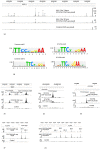Identification of STAT5A and STAT5B target genes in human T cells
- PMID: 24497979
- PMCID: PMC3907443
- DOI: 10.1371/journal.pone.0086790
Identification of STAT5A and STAT5B target genes in human T cells
Abstract
Signal transducer and activator of transcription (STAT) comprises a family of universal transcription factors that help cells sense and respond to environmental signals. STAT5 refers to two highly related proteins, STAT5A and STAT5B, with critical function: their complete deficiency is lethal in mice; in humans, STAT5B deficiency alone leads to endocrine and immunological problems, while STAT5A deficiency has not been reported. STAT5A and STAT5B show peptide sequence similarities greater than 90%, but subtle structural differences suggest possible non-redundant roles in gene regulation. However, these roles remain unclear in humans. We applied chromatin immunoprecipitation followed by DNA sequencing using human CD4(+) T cells to detect candidate genes regulated by STAT5A and/or STAT5B, and quantitative-PCR in STAT5A or STAT5B knock-down (KD) human CD4(+) T cells to validate the findings. Our data show STAT5A and STAT5B play redundant roles in cell proliferation and apoptosis via SGK1 interaction. Interestingly, we found a novel, unique role for STAT5A in binding to genes involved in neural development and function (NDRG1, DNAJC6, and SSH2), while STAT5B appears to play a distinct role in T cell development and function via DOCK8, SNX9, FOXP3 and IL2RA binding. Our results also suggest that one or more co-activators for STAT5A and/or STAT5B may play important roles in establishing different binding abilities and gene regulation behaviors. The new identification of these genes regulated by STAT5A and/or STAT5B has major implications for understanding the pathophysiology of cancer progression, neural disorders, and immune abnormalities.
Conflict of interest statement
Figures



Similar articles
-
Differentiating the roles of STAT5B and STAT5A in human CD4+ T cells.Clin Immunol. 2013 Aug;148(2):227-36. doi: 10.1016/j.clim.2013.04.014. Epub 2013 May 5. Clin Immunol. 2013. PMID: 23773921 Free PMC article.
-
A sequence of the CIS gene promoter interacts preferentially with two associated STAT5A dimers: a distinct biochemical difference between STAT5A and STAT5B.Mol Cell Biol. 1998 Oct;18(10):5852-60. doi: 10.1128/MCB.18.10.5852. Mol Cell Biol. 1998. PMID: 9742102 Free PMC article.
-
Signal transducer and activator of transcription (STAT)-5A and STAT5B differentially regulate human mammary carcinoma cell behavior.Endocrinology. 2010 Jan;151(1):43-55. doi: 10.1210/en.2009-0651. Epub 2009 Dec 4. Endocrinology. 2010. PMID: 19966185
-
Stat5a and Stat5b: fraternal twins of signal transduction and transcriptional activation.Cytokine Growth Factor Rev. 1999 Jun;10(2):131-57. doi: 10.1016/s1359-6101(99)00011-8. Cytokine Growth Factor Rev. 1999. PMID: 10743504 Review.
-
Interpretation of cytokine signaling through the transcription factors STAT5A and STAT5B.Genes Dev. 2008 Mar 15;22(6):711-21. doi: 10.1101/gad.1643908. Genes Dev. 2008. PMID: 18347089 Free PMC article. Review.
Cited by
-
GRAM domain-containing protein 1A (GRAMD1A) promotes the expansion of hepatocellular carcinoma stem cell and hepatocellular carcinoma growth through STAT5.Sci Rep. 2016 Sep 2;6:31963. doi: 10.1038/srep31963. Sci Rep. 2016. PMID: 27585821 Free PMC article.
-
STAT5 inhibition induces TRAIL/DR4 dependent apoptosis in peripheral T-cell lymphoma.Oncotarget. 2018 Mar 30;9(24):16792-16806. doi: 10.18632/oncotarget.24698. eCollection 2018 Mar 30. Oncotarget. 2018. PMID: 29682185 Free PMC article.
-
STAT5a Confers Doxorubicin Resistance to Breast Cancer by Regulating ABCB1.Front Oncol. 2021 Jul 15;11:697950. doi: 10.3389/fonc.2021.697950. eCollection 2021. Front Oncol. 2021. PMID: 34336684 Free PMC article.
-
High incidence of activating STAT5B mutations in CD4-positive T-cell large granular lymphocyte leukemia.Blood. 2016 Nov 17;128(20):2465-2468. doi: 10.1182/blood-2016-06-724856. Epub 2016 Oct 3. Blood. 2016. PMID: 27697773 Free PMC article. No abstract available.
-
JAK/STAT-Activating Genomic Alterations Are a Hallmark of T-PLL.Cancers (Basel). 2019 Nov 21;11(12):1833. doi: 10.3390/cancers11121833. Cancers (Basel). 2019. PMID: 31766351 Free PMC article.
References
-
- Lin JX, Leonard WJ (2000) The role of Stat5a and Stat5b in signaling by IL-2 family cytokines. Oncogene 19: 2566–2576. - PubMed
-
- Leonard WJ, O'Shea JJ (1998) Jaks and STATs: biological implications. Annu Rev Immunol 16: 293–322. - PubMed
-
- Lin JX, Mietz J, Modi WS, John S, Leonard WJ (1996) Cloning of human Stat5B. Reconstitution of interleukin-2-induced Stat5A and Stat5B DNA binding activity in COS-7 cells. J Biol Chem 271: 10738–10744. - PubMed
Publication types
MeSH terms
Substances
Grants and funding
LinkOut - more resources
Full Text Sources
Other Literature Sources
Research Materials
Miscellaneous

